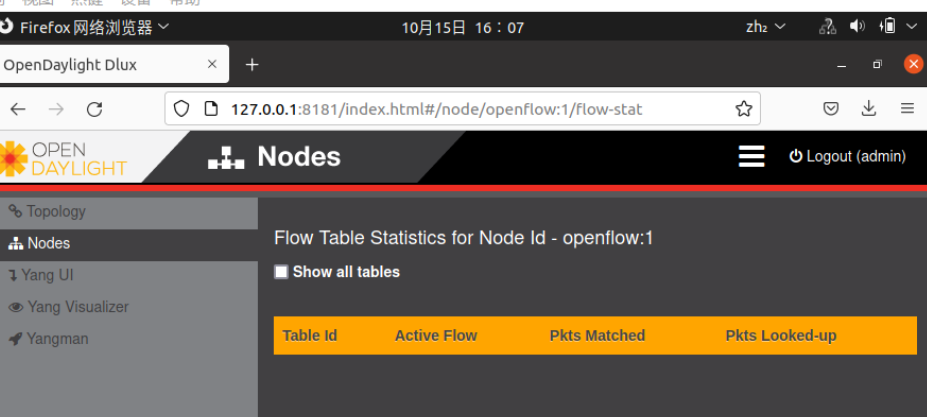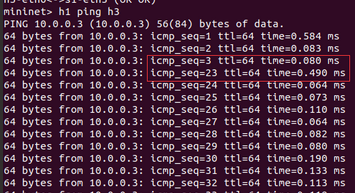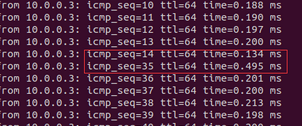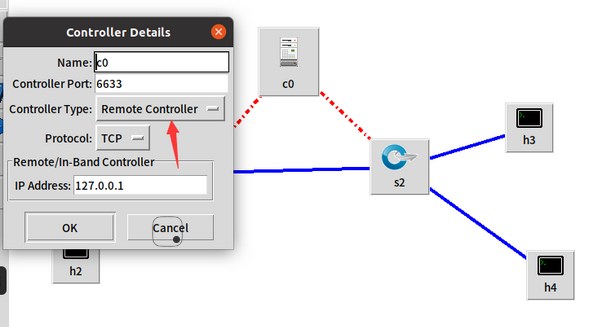SDN第七次上机作业
(一)基础要求
OpenDaylight
1.利用Mininet平台搭建下图所示网络拓扑,并连接OpenDaylight;
- 搭建拓扑:sudo mn --topo=single,3 --mac --controller=remote,ip=127.0.0.1,port=6633 --switch ovsk,protocols=OpenFlow10
- 连接OpenDaylight(ODL目录下):./distribution-karaf-0.6.4-Carbon/bin/karaf
2.编写Python程序,调用OpenDaylight的北向接口下发指令删除s1上的流表数据。
def http_detele(url):
url = url
headers = {'Content-Type': 'application/json'}
resp = requests.delete(url, headers=headers, auth=HTTPBasicAuth('admin', 'admin'))
return resp
if __name__ == '__main__':
url = 'http://127.0.0.1:8181/restconf/config/opendaylight-inventory:nodes/node/openflow:1/'
with open('test.json') as f:
jstr = f.read()
resp = http_detele(url)
print(resp.content)

3.编写Python程序,调用OpenDaylight的北向接口下发硬超时流表,实现拓扑内主机h1和h3网络中断20s。
import requests
from requests.auth import HTTPBasicAuth
def http_put(url,jstr):
url= url
headers = {'Content-Type':'application/json'}
resp = requests.put(url,jstr,headers=headers,auth=HTTPBasicAuth('admin', 'admin'))
return resp
if __name__ == "__main__":
url='http://127.0.0.1:8181/restconf/config/opendaylight-inventory:nodes/node/openflow:1/flow-node-inventory:table/0/flow/1'
with open('206.json') as f:
jstr = f.read()
resp = http_put(url,jstr)
print (resp.content)

4.编写Python程序,调用OpenDaylight的北向接口获取s1上活动的流表数
import requests
import json
from requests.auth import HTTPBasicAuth
def http_get(url):
url= url
headers = {'Content-Type':'application/json'}
resp = requests.get(url,headers=headers,auth=HTTPBasicAuth('admin','admin'))
return resp
if __name__ == "__main__":
url = 'http://127.0.0.1:8181/restconf/operational/opendaylight-inventory:nodes/node/openflow:1/flow-node-inventory:table/0/opendaylight-flow-table-statistics:flow-table-statistics'
with open('206.json') as f:
jstr = f.read()
resp = http_get(url)
print(resp.content)

ryu
1.编写Python程序,调用Ryu的北向接口,实现上述OpenDaylight实验拓扑上相同的硬超时流表下发。
json:
{
"dpid": 1,
"match": {
"in-port": "1",
"dl_dst": "00:00:00:00:00:03"
},
"priority": 65535,
"hard_timeout": 20,
"cookie": "2",
"table_id": 0,
"actions": []
}
python
import requests
from requests.auth import HTTPBasicAuth
def http_post(url,jstr):
url= url
headers = {'Content-Type':'application/json'}
resp = requests.post(url,jstr,headers=headers)
return resp
if __name__ == "__main__":
url='http://127.0.0.1:8080/stats/flowentry/add'
with open('206-Ryu-1.json') as f:
jstr = f.read()
resp = http_post(url,jstr)
print (resp.content)

2.利用Mininet平台搭建下图所示网络拓扑,要求支持OpenFlow 1.3协议,主机名、交换机名以及端口对应正确。
- 拓扑生成后需连接Ryu,且Ryu应能够提供REST API服务。

- 连接Ryu:ryu-manager ryu/ryu/app/gui_topology/gui_topology.py --observe-links

3.整理一个Shell脚本,参考Ryu REST API的文档,利用curl命令,实现和实验2相同的VLAN。
curl -X POST -d '{
"dpid": 1,
"match": {
"in_port": 1
},
"actions": [
{
"type": "PUSH_VLAN",
"ethertype": 33024
},
{
"type": "SET_FIELD",
"field": "vlan_vid",
"value": 4096
},
{
"type":"OUTPUT",
"port": 3
}
],
"priority":5
}' http://localhost:8080/stats/flowentry/add
curl -X POST -d '
{
"dpid": 1,
"priority":5,
"match": {
"in_port": 2
},
"actions": [
{
"type": "PUSH_VLAN",
"ethertype": 33024
},
{
"type": "SET_FIELD",
"field": "vlan_vid",
"value": 4097
},
{
"type":"OUTPUT",
"port": 3
}
]
}' http://localhost:8080/stats/flowentry/add
curl -X POST -d '
{
"dpid": 1,
"match": {
"vlan_vid": 0
},
"actions": [
{
"type": "POP_VLAN",
"ethertype": 33024
},
{
"type":"OUTPUT",
"port": 1
}
],
"priority":5
}
' http://localhost:8080/stats/flowentry/add
curl -X POST -d'
{
"dpid": 1,
"match": {
"vlan_vid": 1
},
"actions": [
{
"type": "POP_VLAN",
"ethertype": 33024
},
{
"type":"OUTPUT",
"port": 2
}
],
"priority":5
}
' http://localhost:8080/stats/flowentry/add
curl -X POST -d '{
"dpid": 2,
"match": {
"in_port": 1
},
"actions": [
{
"type": "PUSH_VLAN",
"ethertype": 33024
},
{
"type": "SET_FIELD",
"field": "vlan_vid",
"value": 4096
},
{
"type":"OUTPUT",
"port": 3
}
],
"priority":5
}' http://localhost:8080/stats/flowentry/add
curl -X POST -d '
{
"dpid": 2,
"match": {
"in_port": 2
},
"actions": [
{
"type": "PUSH_VLAN",
"ethertype": 33024
},
{
"type": "SET_FIELD",
"field": "vlan_vid",
"value": 4097
},
{
"type":"OUTPUT",
"port": 3
}
],
"priority":5
}' http://localhost:8080/stats/flowentry/add
curl -X POST -d '
{
"dpid": 2,
"match": {
"vlan_vid": 0
},
"actions": [
{
"type": "POP_VLAN",
"ethertype": 33024
},
{
"type":"OUTPUT",
"port": 1
}
],
"priority":5
}
' http://localhost:8080/stats/flowentry/add
curl -X POST -d'
{
"dpid": 2,
"match": {
"vlan_vid": 1
},
"actions": [
{
"type": "POP_VLAN",
"ethertype": 33024
},
{
"type":"OUTPUT",
"port": 2
}
],
"priority":5
}' http://localhost:8080/stats/flowentry/add

(二)进阶要求
编程实现基本要求第2部分Ryu(3)中的VLAN划分
#!/usr/bin/python
import requests
from requests.auth import HTTPBasicAuth
def http_post(url, js):
url = url
headers = {'Content-Type': 'application/json'}
resp = requests.post(url, jstr, headers=headers)
return resp
if __name__ == '__main__':
url = 'http://localhost:8080/stats/flowentry/add'
for i in range(1, 9):
with open('%s.json' % i) as f:
jstr = f.read()
resp = http_post(url, jstr)
print(resp.content)
(三)实验总结
- 本次实验要感谢荆宇飞,颜佳灿两位同学的指导
- 作业参考:
https://www.cnblogs.com/jingyufei/p/15425653.html
https://www.cnblogs.com/Moonlightcode/p/15416597.html - json文件参考:
https://blog.csdn.net/weixin_39793434/article/details/111509659 - ODL缺少组件参考:
“odl安装的一些坑”:
https://blog.csdn.net/zengxiaosen/article/details/72864594
“OpenDaylight安装feature时出现Error executing command: Can't install feature问题”:
https://blog.csdn.net/u011412226/article/details/80243612 - ODL部分:
看了同学的做法之后知道了怎么修改python代码,然后发现没有json文件
同学给了一个连接,参照连接完成了json文件的编写(其实不难)
ODL1-3差不多,代码改改就好了 - Ryu部分:
在完成了ODL的实验之后,有其他作业参照的情况下 Ryu部分不是很难(非常感谢最初几位完成作业的同学,他们通过不断地试错修改才得到正确的答案)
miniedit连接ryu时要设置这个

Ryu的第三个小节我研究了很长时间,学到很多 - 进阶?没有进阶,我懒doge
- 再次推荐https://www.cnblogs.com/Moonlightcode/p/15416597.html



